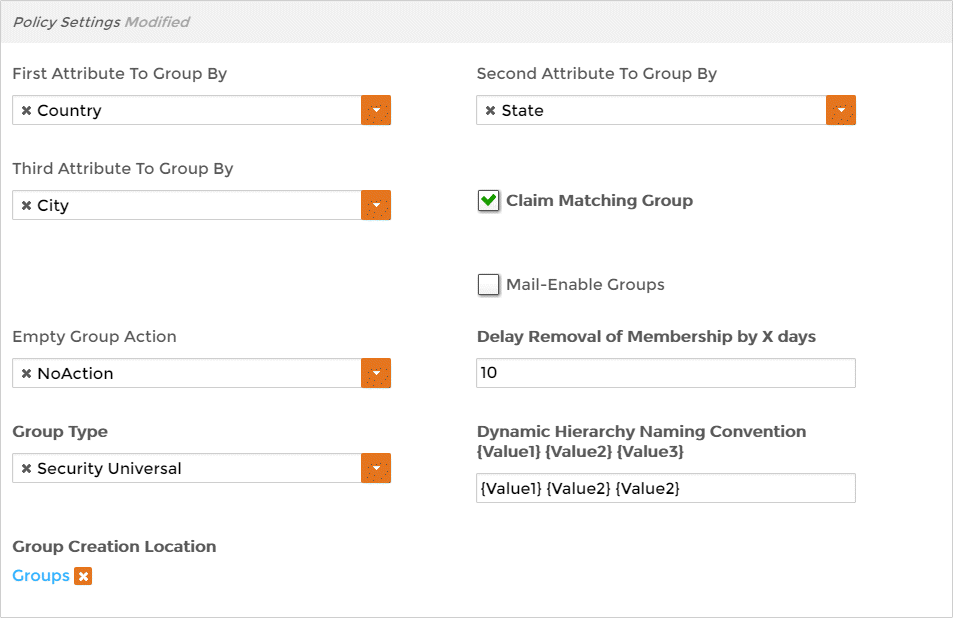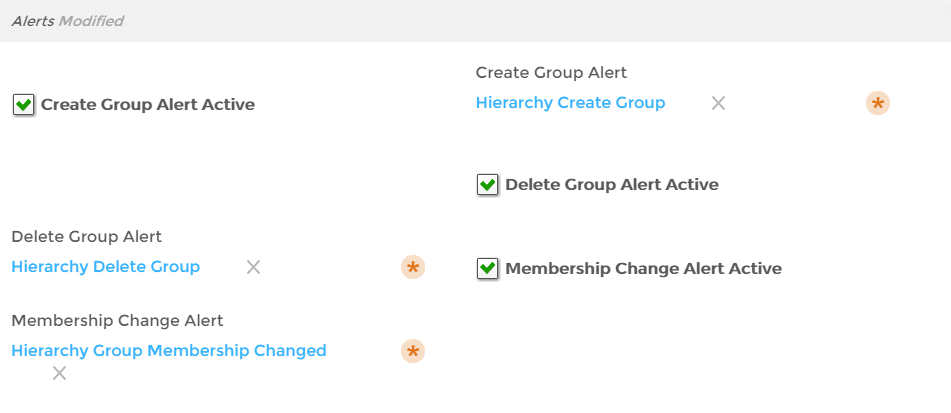You are viewing an earlier version of the admin guide. For the latest version, please visit EmpowerID Admin Guide v7.211.0.0.
One-Level Triple Attributes
EmpowerID provides the capability for you to create Dynamic Hierarchy policies that allow groups to be dynamically generated based on the value of any three specified Person attributes, such as the State, City and Country attributes. When the policy runs, EmpowerID creates a group for the specified attributes. EmpowerID then places any Person accounts with those matching attributes in the group.
The Extension Attribute 1 and Extension Attribute 2 values for each group created by a Dynamic Hierarchy policy are internally managed by EmpowerID and should not be altered.
To create a one-level triple attribute groups Dynamic Hierarchy Policy
- In the navigation sidebar, expand Admin, then Policies, and click Dynamic Hierarchies.
- From the Dynamic Hierarchies find page, click the Add (+) button.
- In the Choose Type section of the Policy Details form that appears, select One level dual attribute groups from the Select a Policy Type drop-down.
- In the General section of the Create Dynamic Hierarchy Policy form, do the following:
- Type a name and description for the policy in the Name and Description fields, respectively.
- Select the appropriate account store where the group is to be created from the Directory drop-down.
- In the Hierarchy Generation section of the Policy Details form, do the following:
- Select Hierarchy Generation Enabled so that the option is enabled. Doing so allows EmpowerID to generate the dynamic group hierarchies.
- Click the Hierarchy Generation Next Run field and in the calendar control that appears, specify the date and time for the next run of the Hierarchy Generation job.
Optionally, underneath Hierarchy Generation Schedule, click the Start and End fields and in the calendar control that appears for each field, specify the respective start and end dates for hierarchy generation to occur.
The default start date is the current day and the end date is 97 years from the start date.
- Specify the occurrence interval for the hierarchy generation from the Interval pane. When doing so, you have the following options:
- Once - Hierarchy generation occurs one time.
- Minute Interval - Hierarchy generation occurs "X" times every "Y" minutes as specified in the Run Indefinitely, Iterations and Interval fields. So, for example, if you select an iteration of 2 and an interval of 24, hierarchy generation occurs twice. The first occurrence is at the date and time specified in the Hierarchy Generation Next Run field and the second occurrence is 24 minutes after the first run completes. However, if you select Run Indefinitely, and then select an Interval of 24, hierarchy generation occurs once every 24 minutes, indefinitely.
- Hour Interval - Hierarchy generation occurs "X" times every "Y" hours as specified in the Run Indefinitely, Iterations and Interval fields. So, for example, if you select an iteration of 2 and an interval of 24, hierarchy generation occurs twice. The first occurrence is at the date and time specified in the Hierarchy Generation Next Run field and the second occurrence is 24 hours after the first run completes. However, if you select Run Indefinitely, and then select an Interval of 24, hierarchy generation occurs once every 24 hours, indefinitely.
- Daily - Hierarchy generation occurs once every "X" days at a designated time as specified in the Run Indefinitely, Iterations and Times fields. So, for example, if you select an iteration of 2, hierarchy generation occurs twice. The first occurrence is at the date and time specified in the Hierarchy Generation Next Run field and the second occurrence is on the following day at the time specified in the Times field. However, if you select Run Indefinitely, hierarchy generation occurs on a daily basis at the time specified in the Times field.
- In the Membership Recalculation section of the Policy Details form, do the following:
- Select Membership Recalculation Enabled so that the option is enabled. Doing so allows EmpowerID to update group membership as specified.
- Click the Membership Recalculate Next Run field and in the calendar control that appears, specify the date and time for the next run of the Dynamic Hierarchy Membership Recalculation job.
Optionally, underneath Membership Recalculation Schedule, click the Start and End fields and in the calendar control that appears for each field, specify the respective start and end dates for hierarchy generation to occur.
The default values for these fields is a start schedule of one day before the current day and an end date of 97 years from the start date. If you change these values, the Start date should be set to one day before the date specified in the Membership Recalculate Next Run field to ensure the generation occurs as expected.
- Specify the occurrence interval for the hierarchy generation from the Interval pane. When doing so, you have the following options:
- Once - Membership recalculation occurs one time.
- Minute Interval - Membership recalculation occurs "X" times every "Y" minutes as specified in the Run Indefinitely, Iterations and Interval fields. So, for example, if you select an iteration of 2 and an interval of 24, membership recalculation occurs twice. The first occurrence is at the date and time specified in the Membership Recalculate Next Run field and the second occurrence is 24 minutes after the first run completes. However, if you select Run Indefinitely, and then select an Interval of 24, membership recalculation occurs once every 24 minutes, indefinitely.
- Hour Interval - Membership recalculation occurs "X" times every "Y" hours as specified in the Run Indefinitely, Iterations and Interval fields. So, for example, if you select an iteration of 2 and an interval of 24, membership recalculation occurs twice. The first occurrence is at the date and time specified in the Membership Recalculate Next Run field and the second occurrence is 24 hours after the first run completes. However, if you select Run Indefinitely, and then select an Interval of 24, membership recalculation occurs once every 24 hours, indefinitely.
- Daily - Membership recalculation occurs once every "X" days at a designated time as specified in the Run Indefinitely, Iterations and Times fields. So, for example, if you select an iteration of 2, membership recalculation occurs twice. The first occurrence is at the date and time specified in the Membership Recalculation Next Run field and the second occurrence is on the following day at the time specified in the Times field. However, if you select Run Indefinitely, membership recalculation occurs on a daily basis at the time specified in the Times field.
- In the Policy Settings section of the Policy Details form, do the following:
- Select an attribute from the First Attribute To Group By drop-down.
- Select an attribute from the Second Attribute To Group By drop-down.
- Select an attribute from the Third Attribute To Group By drop-down.
Select whether to Claim Matching Group.
If this option is selected and the group already exists in the specified OU, EmpowerID claims that group as a Dynamic Hierarchy group instead of creating a new one. If an existing group is claimed, EmpowerID fully manages the membership of that group, adding and removing users from those groups based on the criteria set for group membership.
You can add people to Dynamic Hierarchy groups using RBAC policies, but you cannot remove them.
When selecting this option, be aware that any people in the group who do not match the criteria for group membership are removed, unless they have been added to the group as an RBAC delegation.
- Select whether to Mail-Enable Groups. Please note that Exchange or Office 365 is required for this setting.
- Select the action for EmpowerID to take if a group is empty from the Empty Group Action drop-down. You can take No Action, Disable or Delete the group.
- In the Delay Removal of Membership by X Days field, specify the number of days EmpowerID waits before removing people who no longer meet the criteria for group membership. This allows you to give people moving from one location to another to have access to whatever resources the policy gives to them. If the value is left blank, EmpowerID immediately removes all people no longer meeting the criteria for group membership.
- Select the type of group you wish EmpowerID to create from the Group Type drop-down.
- In the Dynamic Hierarchy Naming Convention {Value1} {Value2} {Value3} field, at a minimum enter {Value1} {Value2} {Value3}. EmpowerID uses these values to dynamically create a separate group for each person or user account meeting the criteria for the group. You can add additional text if desired as long as you include the placeholder values.
- Click Group Creation Location and then select an OU where EmpowerID provisions the dynamically generated group. If you do not pick a location, EmpowerID creates these groups in the default group creation location selected for the account store.
After completing the above, the Policy Settings section of the form looks similar to the following image:
- In the Alerts section, select or deselect Alerts based on the action taken:
- Create Group Alert Active - Select this option if you wish for the alert chosen for the Create Group Alert setting to be sent to subscribers when a group is created based on the dynamic group hierarchy policy settings.
- Create Group Alert - When Create Group Alert Active is enabled (checked), this sends an alert to subscribers when EmpowerID creates a new group from the policy. By default, the alert is set to the Hierarchy Create Group alert.
- Delete Group Alert Active - Select this option if you wish for the alert chosen for the Delete Group Alert setting to be sent when a group is deleted based on the dynamic group hierarchy policy settings. The specific setting that governs whether or not a group is automatically deleted is the Empty Group Action setting. If that field is set to Delete, the only time EmpowerID deletes a dynamic group is when there are no members in the group.
- Delete Group Alert - When Create Group Alert Active is enabled (checked), this sends an alert to subscribers when EmpowerID deletes a group that was previously created from the policy.
- Membership Change Alert Active - Select this option if you wish for the alert chosen for the Membership Change Alert setting to be sent to subscribers when the membership of the dynamic group hierarchy changes.
Membership Change Alert - When Membership Change Alert Active is enabled (checked), this sends an alert when the membership of a group created by the policy is changed by the policy. By default, the alert is set to Hierarchy Group Membership Changed alert.
EmpowerID includes default Alert email templates that are automatically selected for each type of Alert, but custom email alerts can be defined and selected as needed. To do so, click the Remove button to the right of the alert you wish to replace and then search for and select the appropriate alert. If you click the link for the alert rather than the Remove button, EmpowerID directs your browser to the View One page for the alert.
The following image shows what the Alerts section looks like with all Alerts selected.
- Click Save.
After the Dynamic Hierarchy Policy runs, you is able to see the new groups provisioned by the policy in a Group search. You can also view the Dynamic Hierarchy Membership Inbox and Dynamic Hierarchy Provision Inbox by expanding System Logs and clicking Dynamic Hierarchy Inbox on the Navigation Sidebar.
You can view the people who have been dynamically added to the group by clicking on the Display Name link for that group and expanding the Resultant Members accordion on the View One page for the group that appears.


